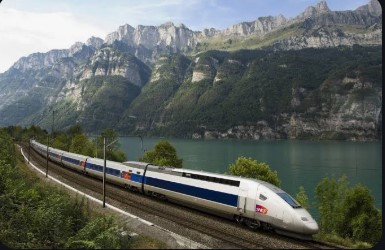France is a country that feels like a dream—majestic cities, rolling vineyards, picturesque villages, and an irresistible mix of culture, history, and cuisine. And there’s arguably no better way to see it all than by train. Whether you’re sipping espresso at a Parisian café or gazing at lavender fields in Provence, traveling by rail offers a relaxed, scenic, and eco-friendly way to discover the diverse beauty of France.
At Travel Express, we’ve put together the ultimate guide to help you travel across France by train with ease. From high-speed TGVs to charming regional routes, this is everything you need to know before you hop aboard.
Why Travel by Train in France?
France has one of the most advanced rail networks in the world, and for good reason:
- Speed: The TGV (Train à Grande Vitesse) can whisk you from Paris to Marseille in just over 3 hours.
- Convenience: Train stations are usually centrally located—no need for long airport transfers.
- Scenery: Rail routes offer some of the most beautiful views in Europe, especially in regions like the Loire Valley, Alsace, and the Alps.
- Sustainability: Trains are one of the most eco-friendly modes of travel.
Whether you’re planning a quick city break or a multi-region adventure, France’s trains are fast, frequent, and famously efficient.
Understanding the French Rail System
1. SNCF – The Heart of the Network
SNCF (Société Nationale des Chemins de fer Français) is France’s national rail company. It operates nearly all rail services, including high-speed, intercity, and regional trains.
2. TGV – The High-Speed Marvel
TGV trains are the pride of French engineering. They connect major cities at lightning speeds—up to 320 km/h (199 mph). Ideal for long distances and business or luxury travel.
- Key TGV Routes:
- Paris to Lyon – 2 hours
- Paris to Bordeaux – 2 hours
- Paris to Nice – 6 hours
- Paris to Strasbourg – 1h 45m
3. TER – Regional Exploration
TER (Transport Express Régional) trains are slower but offer access to smaller towns and rural regions. Great for wine country tours, day trips, or hopping between charming villages.
- Popular TER Routes:
- Avignon to Arles
- Lyon to Annecy
- Bordeaux to Saint-Émilion
4. Intercités – The Middle Ground
These connect cities that aren’t served by TGV. They’re comfortable, scenic, and usually cheaper.
Booking Train Tickets
1. Where to Book
- Official SNCF website: www.sncf.com
- Rail Europe: Perfect for English speakers and international travelers
- Oui.sncf & Trainline: Easy-to-use mobile apps and websites
2. When to Book
For TGV and Intercités, book as early as possible—up to 3 months in advance—for the best prices. TER tickets usually don’t vary in price, so last-minute bookings are okay.
3. Seat Reservations
- Required: TGV and Intercités (you must reserve a seat)
- Not Required: TER trains (open seating)
Top Scenic Train Journeys in France
1. Paris to Nice (via TGV)
From the bustling capital to the glittering Côte d’Azur, this journey covers a range of landscapes—rolling countryside, lavender fields, and sparkling Mediterranean views.
2. Strasbourg to Colmar (via TER)
Short but sweet, this ride through Alsace offers storybook towns, vineyards, and half-timbered houses.
3. Lyon to Annecy
Perfect for nature lovers. The route winds through the Alpine foothills, ending at a peaceful lakeside town.
4. Toulouse to Carcassonne
Enjoy a charming ride into medieval history, culminating at the walled fortress city of Carcassonne.
5. Nice to Monaco to Menton (TER)
Ride along the Riviera with sweeping sea views and colorful cliffside towns.
Rail Passes: Are They Worth It?
If you plan to take multiple long-distance trains, a rail pass might save you money.
1. Eurail France Pass (for non-EU residents)
- Unlimited travel on the national rail network
- Choose from 3 to 8 travel days within a month
- Great for flexibility and scenic detours
2. France Rail Pass (for EU residents)
- Similar perks, tailored for European travelers
Tip: Even with a pass, TGV and Intercités still require seat reservations (additional cost).
Practical Tips for Train Travel in France
1. Validate Your Ticket (Composter le billet)
For TER trains, you’ll need to validate your paper ticket in the yellow machines before boarding. Digital tickets don’t need this.
2. Arrive Early for TGV
Plan to be at the station 15-20 minutes before departure. Platforms are announced about 10 minutes prior.
3. Travel Light if You Can
There are no luggage weight limits, but space is limited—especially on popular routes.
4. Mind the Strikes
France has a reputation for rail strikes. Always check SNCF’s site or Twitter before traveling.
5. Download the SNCF App
Real-time schedules, mobile tickets, and platform info all in one place.
Sample Itineraries for Inspiration
✨ The Romantic Route (7 days)
- Day 1–3: Paris
- Day 4: Train to Reims (Champagne tasting)
- Day 5–6: Train to Strasbourg (Alsace region)
- Day 7: Return to Paris
🍷 The Wine Trail (5 days)
- Day 1–2: Bordeaux (wine tours)
- Day 3: TER to Saint-Émilion
- Day 4–5: Train to Lyon (Beaujolais region)
🌊 The Riviera Escape (6 days)
- Day 1–2: Nice
- Day 3: Day trip to Monaco
- Day 4–5: Train to Marseille
- Day 6: Explore Calanques National Park




